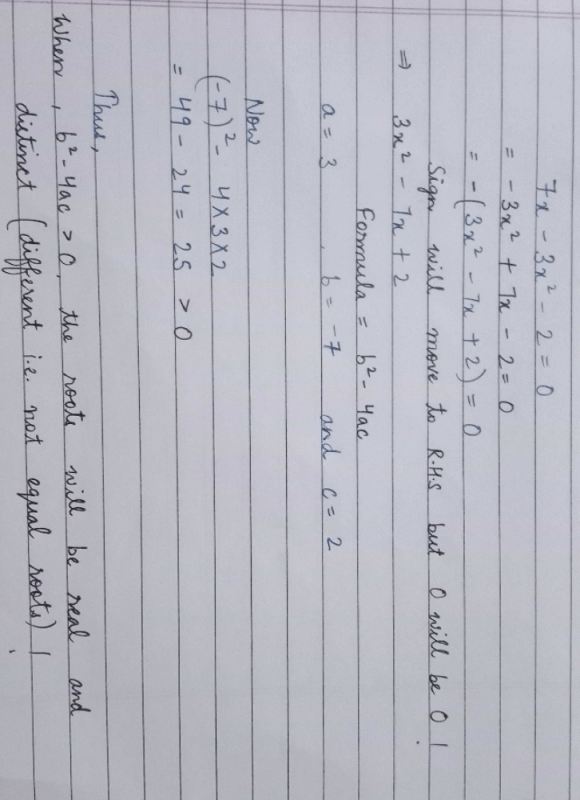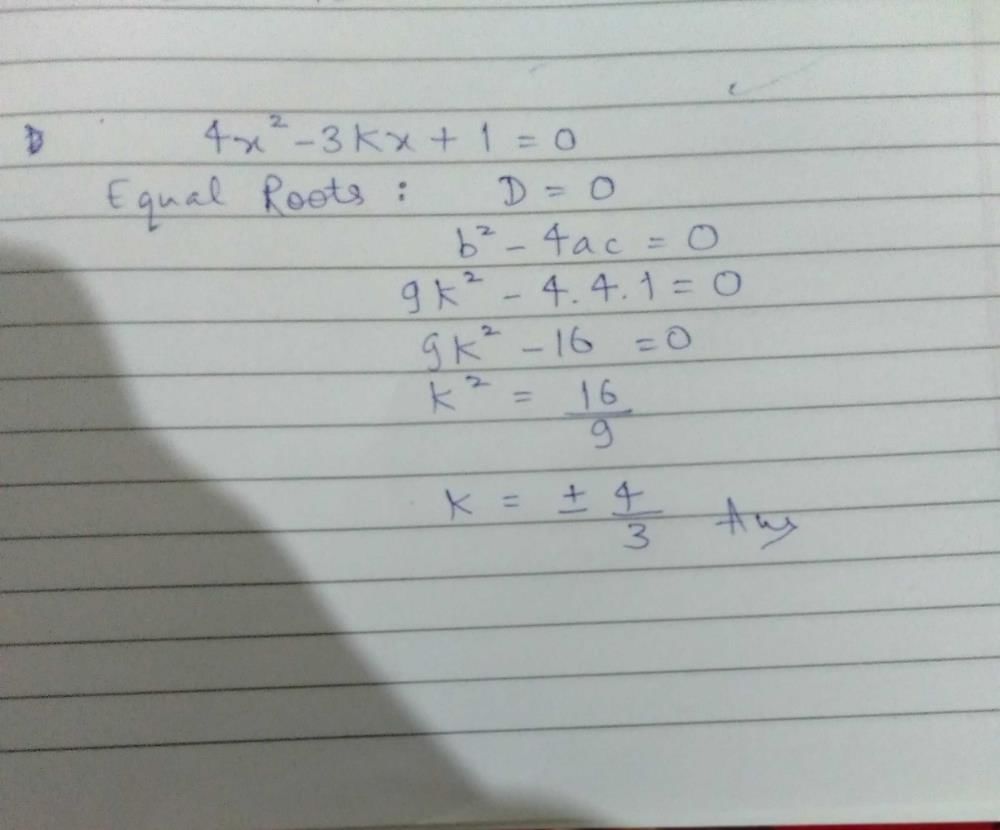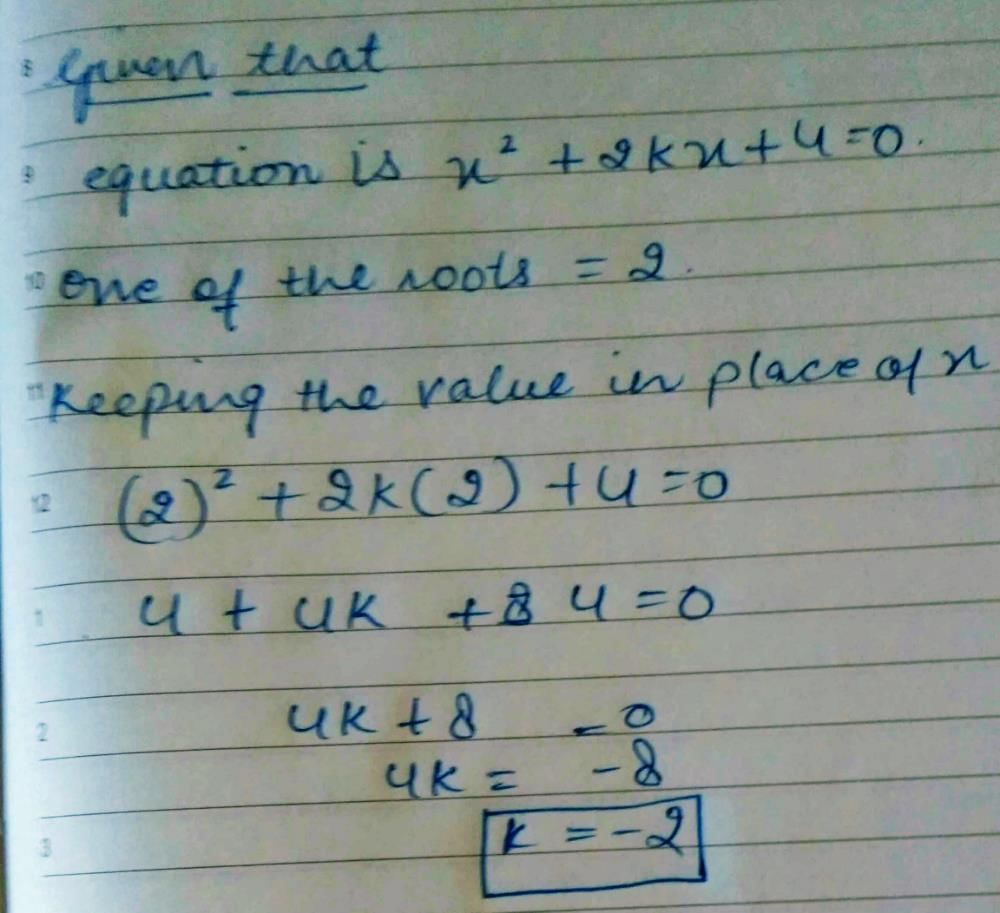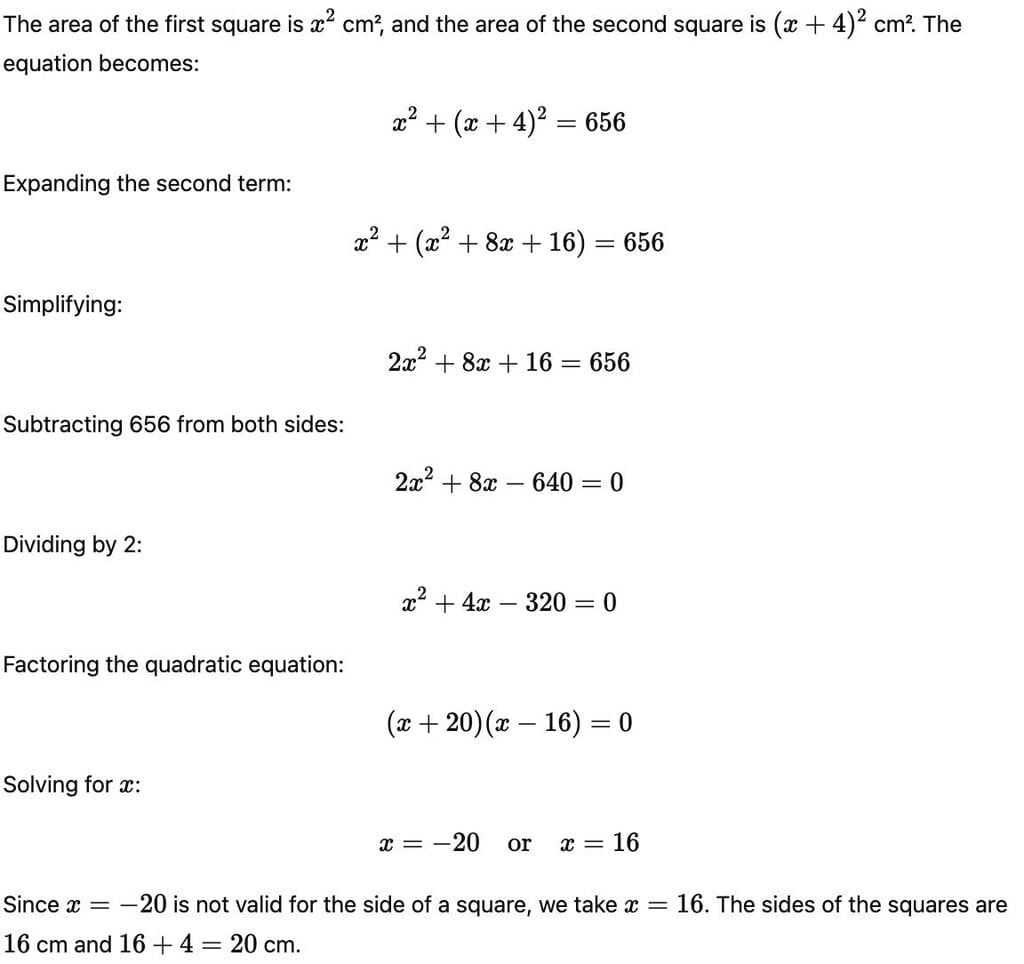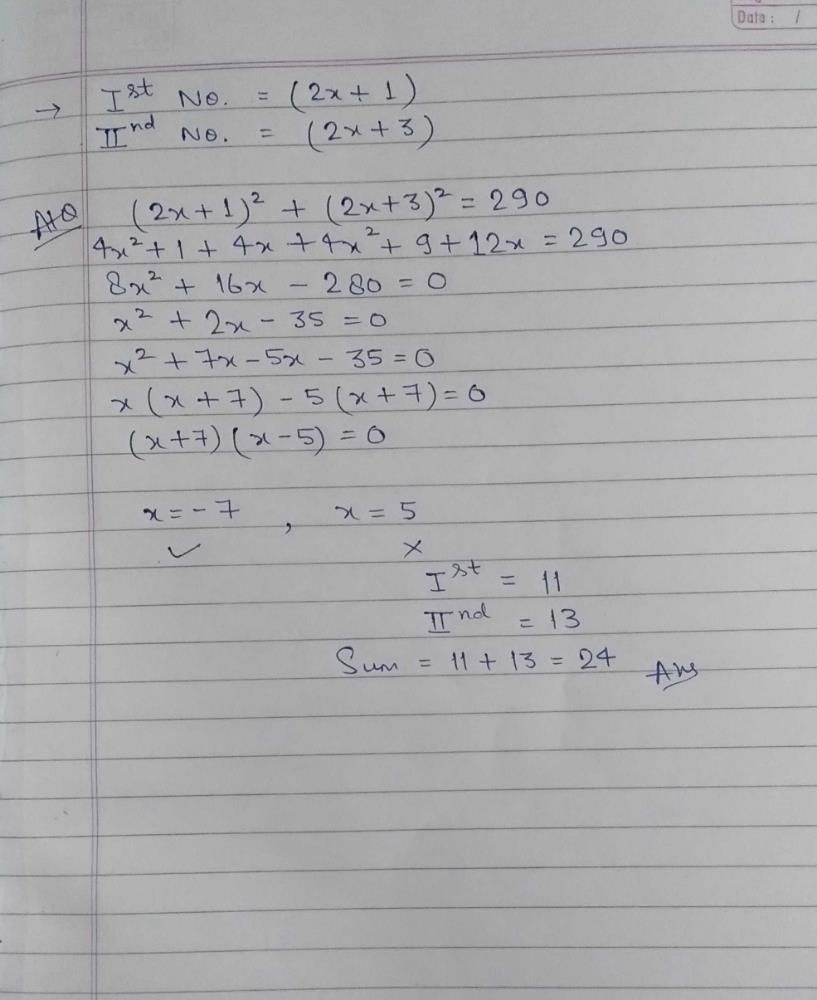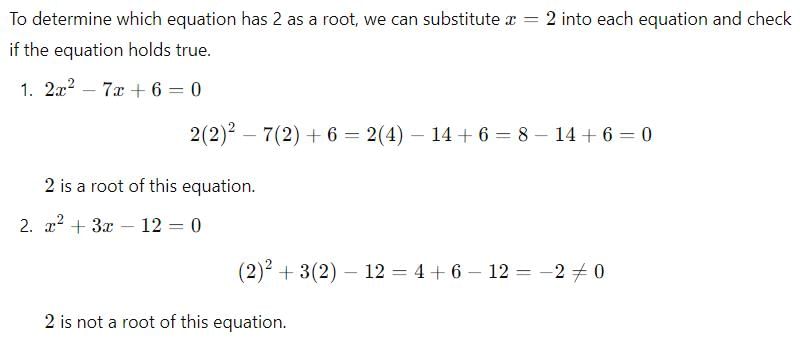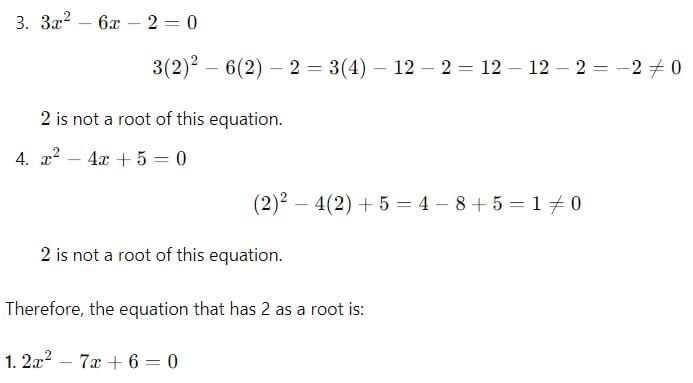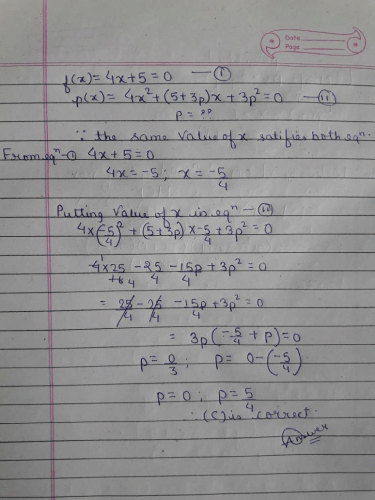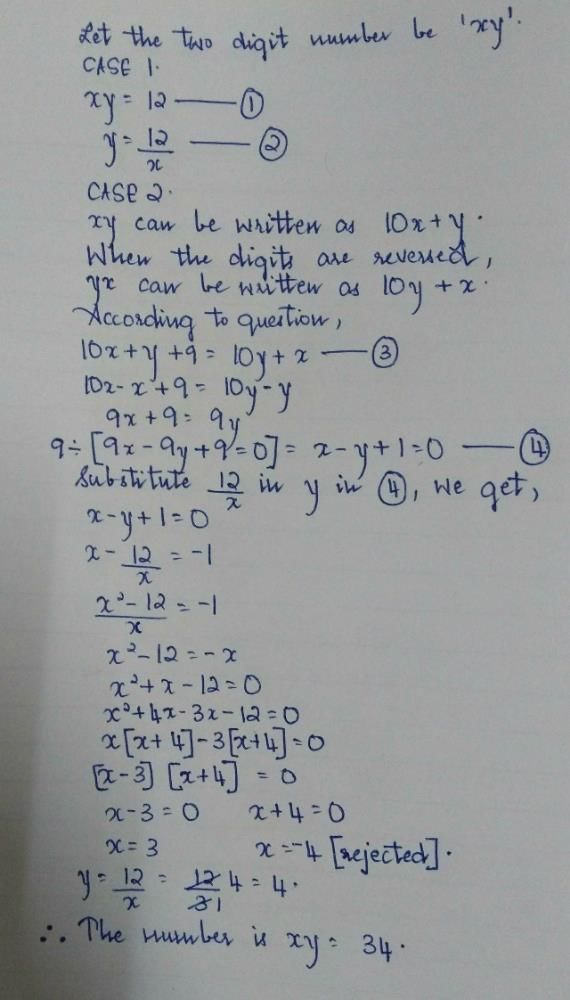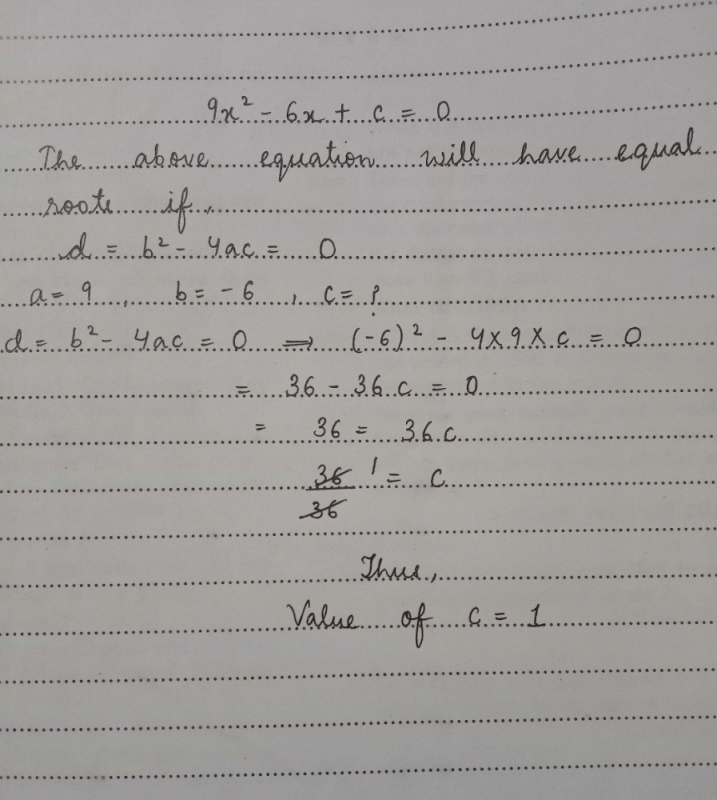All Exams >
Class 10 >
Mathematics Class 10 (Maharashtra SSC Board) >
All Questions
All questions of Quadratic Equations for Class 10 Exam
Solve 9x2 = 36- a)±2
- b)±6
- c)±4
- d)2
Correct answer is option 'A'. Can you explain this answer?
Solve 9x2 = 36
a)
±2
b)
±6
c)
±4
d)
2
|
|
Nilanjan Shah answered |
Solution:
To solve this equation, we need to isolate the variable x.
Given equation is 9x2 = 36
Step 1: Divide both sides by 9
9x2/9 = 36/9
Step 2: Simplify
x2 = 4
Step 3: Take square root on both sides
√(x2) = √4
Step 4: Simplify
x = ±2
Therefore, the solution of the given equation 9x2 = 36 is x = ±2.
Explanation:
The given equation is a quadratic equation in which we need to find the value of x. To solve the equation, we need to isolate the variable x by following the steps mentioned above. We divided both sides by 9 to simplify the equation. After simplification, we got x2 = 4 which means x can be either positive or negative 2. We took the square root of both sides and simplified the equation to get the final solution x = ±2.
To solve this equation, we need to isolate the variable x.
Given equation is 9x2 = 36
Step 1: Divide both sides by 9
9x2/9 = 36/9
Step 2: Simplify
x2 = 4
Step 3: Take square root on both sides
√(x2) = √4
Step 4: Simplify
x = ±2
Therefore, the solution of the given equation 9x2 = 36 is x = ±2.
Explanation:
The given equation is a quadratic equation in which we need to find the value of x. To solve the equation, we need to isolate the variable x by following the steps mentioned above. We divided both sides by 9 to simplify the equation. After simplification, we got x2 = 4 which means x can be either positive or negative 2. We took the square root of both sides and simplified the equation to get the final solution x = ±2.
Write the general form of a quadratic polynomia- a)ax2 + bx + c where a, b and c are real numbers
- b)ax2 + bx + c=0
- c)ax2 + bx + c where a, b and c are real numbers and a is not equal to zero.
- d)ax2 + bx + c or bx + ax2 + c or c+ bx + ax2
Correct answer is option 'C'. Can you explain this answer?
Write the general form of a quadratic polynomia
a)
ax2 + bx + c where a, b and c are real numbers
b)
ax2 + bx + c=0
c)
ax2 + bx + c where a, b and c are real numbers and a is not equal to zero.
d)
ax2 + bx + c or bx + ax2 + c or c+ bx + ax2
|
|
Krishna Iyer answered |
If the coefficient of x2 is zero , then the equation is not a quadratic equation , its a linear equation. So its necessary condition for the quadratic equation.
Which of the following in not a quadratic equation:- a)(x – 2)2 + 1 = 2x – 3
- b)(x + 2)2 = x3 – 4
- c)x(2x + 3) = x2 + 1
- d)x(x + 1) + 8 = (x + 2) (x – 2)
Correct answer is option 'D'. Can you explain this answer?
Which of the following in not a quadratic equation:
a)
(x – 2)2 + 1 = 2x – 3
b)
(x + 2)2 = x3 – 4
c)
x(2x + 3) = x2 + 1
d)
x(x + 1) + 8 = (x + 2) (x – 2)

|
Rahul Kumar answered |
Option (B) and (D) , both are the correct answers. We have x(x + 1) + 8 = (x + 2) (x – 2)
=x2 + x + 8 = x2 - 4
= x = -12, which is not a quadratic equation
Also, in (B) (x + 2)2 = x3 – 4
=x2 +4x + 4=x3 - 4, which is a cubic equation
=x2 + x + 8 = x2 - 4
= x = -12, which is not a quadratic equation
Also, in (B) (x + 2)2 = x3 – 4
=x2 +4x + 4=x3 - 4, which is a cubic equation
Can you explain the answer of this question below: If 4 is a root of the equation  , then k is
, then k is
- A:
-28
- B:
-12
- C:
12
- D:
28
The answer is a.
If 4 is a root of the equation , then k is
-28
-12
12
28

|
Vp Classes answered |
4 is the solution , this means that if we put x=4 we get 0. So putting x=4 in the equation x2+3x+k=0 we get 42+3*4+k=0
16+12+k=0 ⇒ k=-28
16+12+k=0 ⇒ k=-28
Solve for x : 6x2 + 40 = 31x- a)

- b)

- c)0,8/3
- d)None of the above
Correct answer is option 'B'. Can you explain this answer?
Solve for x : 6x2 + 40 = 31x
a)

b)

c)
0,8/3
d)
None of the above
|
|
Nirmal Kumar answered |
6x²-31x+40=0,
a=6,
b=-31,
c=40,
by quadratic formula-->
x=-b±√b²-4ac/2a,
by putting the values of a,b and c, we get,
x=-(-31)±√(-31)²-4(6)(40)/2(6),
=31±√961-960/12,
=31±√1/12,
=31±1/12,
x=30/12or ,32/12,
x=5/2 or, 8/3,
hence , option B is correct
a=6,
b=-31,
c=40,
by quadratic formula-->
x=-b±√b²-4ac/2a,
by putting the values of a,b and c, we get,
x=-(-31)±√(-31)²-4(6)(40)/2(6),
=31±√961-960/12,
=31±√1/12,
=31±1/12,
x=30/12or ,32/12,
x=5/2 or, 8/3,
hence , option B is correct
If x = 1 is a common root of the equation x2 + ax – 3 = 0 and bx2 – 7x + 2 = 0 then ab =
- a)10
- b)-3
- c)6
- d)7
Correct answer is option 'A'. Can you explain this answer?
If x = 1 is a common root of the equation x2 + ax – 3 = 0 and bx2 – 7x + 2 = 0 then ab =
a)
10
b)
-3
c)
6
d)
7
|
|
Zachary Foster answered |
Given:
- x = 1 is a common root of the equations:
- x² + ax - 3 = 0
- bx² - 7x + 2 = 0
To find:
- The value of ab.
Solution:
Since x = 1 is a root of both equations, we can substitute x = 1 in both equations.
Equation 1:
- 1² + a(1) - 3 = 0
- 1 + a - 3 = 0
- a = 2
Equation 2:
- b(1)² - 7(1) + 2 = 0
- b - 7 + 2 = 0
- b = 5
Therefore, ab = 2 * 5 = 10
So, the value of ab is 10.
The value/s of x when (x – 4) (3x + 2) = 0 ________- a)4, -2/3
- b)-4, – 2/ 3
- c)4, 2/3
- d)-4, 2/3
Correct answer is option 'A'. Can you explain this answer?
The value/s of x when (x – 4) (3x + 2) = 0 ________
a)
4, -2/3
b)
-4, – 2/ 3
c)
4, 2/3
d)
-4, 2/3
|
|
Drishti Kumari answered |
( x - 4 ) ( 3x + 2 ) = 0
x - 4 = 0
x = 4
3x + 2 = 0
3x = -2
x = -2 / 3
Therefore option (A) is correct.
x - 4 = 0
x = 4
3x + 2 = 0
3x = -2
x = -2 / 3
Therefore option (A) is correct.
The nature of the roots of the equation x2 – 5x + 7 = 0 is –- a)No real roots
- b)1 real root
- c)Can't be determined
- d)None of these
Correct answer is option 'A'. Can you explain this answer?
The nature of the roots of the equation x2 – 5x + 7 = 0 is –
a)
No real roots
b)
1 real root
c)
Can't be determined
d)
None of these
|
|
Krishna Iyer answered |
Given equation is x2-5x+7=0
We have discriminant as b2-4ac=(-5)2-4*1*7= -3
And x = , Since we do not have any real number which is a root of a negative number, the roots are not real.
, Since we do not have any real number which is a root of a negative number, the roots are not real.
We have discriminant as b2-4ac=(-5)2-4*1*7= -3
And x =
 , Since we do not have any real number which is a root of a negative number, the roots are not real.
, Since we do not have any real number which is a root of a negative number, the roots are not real.Which of the following is not a quadratic equation ?- a)5x + 3y2 = 0
- b)z2 - 2z = 0
- c)3x + 4 - 7x2 = 0
- d)5x2 - 125 = 0
Correct answer is option 'A'. Can you explain this answer?
Which of the following is not a quadratic equation ?
a)
5x + 3y2 = 0
b)
z2 - 2z = 0
c)
3x + 4 - 7x2 = 0
d)
5x2 - 125 = 0
|
|
Priyanshu Intelligent answered |
In equation first there are two variables.
That's why it is not a quadratic equation.
That's why it is not a quadratic equation.
The two positive numbers differ by 5 and square of their sum is 169 are
- a)2,4
- b)5,6
- c)4,9
- d)3,7
Correct answer is option 'C'. Can you explain this answer?
The two positive numbers differ by 5 and square of their sum is 169 are
a)
2,4
b)
5,6
c)
4,9
d)
3,7
|
|
Apoorv khanna answered |
Explanation:
Let the two numbers be x and y, where x is greater than y.
Given, x - y = 5
=> x = y + 5
Also, (x+y)^2 = 169
=> (y+5+y)^2 = 169 (Substituting x = y + 5)
=> (2y+5)^2 = 169
=> 4y^2 + 20y + 25 = 169 (Expanding the square)
=> 4y^2 + 20y - 144 = 0
=> y^2 + 5y - 36 = 0
=> (y + 9)(y - 4) = 0
=> y = -9 or y = 4
Since the numbers are positive, y = 4
Therefore, x = y + 5 = 9
Hence, the two numbers are 4 and 9.
Therefore, option C is the correct answer.
Let the two numbers be x and y, where x is greater than y.
Given, x - y = 5
=> x = y + 5
Also, (x+y)^2 = 169
=> (y+5+y)^2 = 169 (Substituting x = y + 5)
=> (2y+5)^2 = 169
=> 4y^2 + 20y + 25 = 169 (Expanding the square)
=> 4y^2 + 20y - 144 = 0
=> y^2 + 5y - 36 = 0
=> (y + 9)(y - 4) = 0
=> y = -9 or y = 4
Since the numbers are positive, y = 4
Therefore, x = y + 5 = 9
Hence, the two numbers are 4 and 9.
Therefore, option C is the correct answer.
The value of q if x = 2 is a solution of 8x2 + qx – 4 = 0 is _____- a)14
- b)-28
- c)-14
- d)28
Correct answer is option 'C'. Can you explain this answer?
The value of q if x = 2 is a solution of 8x2 + qx – 4 = 0 is _____
a)
14
b)
-28
c)
-14
d)
28
|
|
Kuldeep Raj answered |
Let us place 2 in the place of "x" for 8x² + qx - 4 = 0 (According to the question).
8(2)² + q(2) - 4 = 0.
8(4) + 2q - 4 = 0.
32 + 2q - 4 = 0.
Shift (32) to the right side.
2q - 4 = -32.
Shift (-4) to the right side. Then,
2q = -32 + 4.
2q = -28.
q = -28/2.
q = -14.
Therefore, the value of q if x = 2 is a solution of 8x² + qx - 4 = 0 is -14.
Hence, option (c) is correct friend...
8(2)² + q(2) - 4 = 0.
8(4) + 2q - 4 = 0.
32 + 2q - 4 = 0.
Shift (32) to the right side.
2q - 4 = -32.
Shift (-4) to the right side. Then,
2q = -32 + 4.
2q = -28.
q = -28/2.
q = -14.
Therefore, the value of q if x = 2 is a solution of 8x² + qx - 4 = 0 is -14.
Hence, option (c) is correct friend...
The solution of x2 + 4x + 4 = 0 is- a)2
- b)-2
- c)0
- d)None of these
Correct answer is option 'B'. Can you explain this answer?
The solution of x2 + 4x + 4 = 0 is
a)
2
b)
-2
c)
0
d)
None of these
|
|
Priyanshu Intelligent answered |
(-2)^2 + 4(-2) + 4
= 4 - 8 + 4
=8-8
=0.
Hence , option b) is the right answer.
= 4 - 8 + 4
=8-8
=0.
Hence , option b) is the right answer.
Read the following text and answer the following questions on the basis of the same:
Nidhi and Ria are very close friends. Nidhi’s parents own a Maruti Alto and Ria’s parents own a Toyota Liva. Both the families decided to go for picnic to Somnath temple in Gujarat by their own cars. Nidhi car travels x km/h when Ria’s car travels 5 km/h more than Nidhi’s car Nidhi’s car took 4 hours more than Ria’s car in covering 400 km.
 Q. Which of the following quadratic equations describe the speed of Nidhi’s car?
Q. Which of the following quadratic equations describe the speed of Nidhi’s car?
- a)x2 – 5x – 500 = 0
- b)x2 + 4x – 400 = 0
- c)x2 + 5x – 500 = 0
- d)x2 – 4x + 400 = 0
Correct answer is option 'C'. Can you explain this answer?
Read the following text and answer the following questions on the basis of the same:
Nidhi and Ria are very close friends. Nidhi’s parents own a Maruti Alto and Ria’s parents own a Toyota Liva. Both the families decided to go for picnic to Somnath temple in Gujarat by their own cars. Nidhi car travels x km/h when Ria’s car travels 5 km/h more than Nidhi’s car Nidhi’s car took 4 hours more than Ria’s car in covering 400 km.

Q. Which of the following quadratic equations describe the speed of Nidhi’s car?
a)
x2 – 5x – 500 = 0
b)
x2 + 4x – 400 = 0
c)
x2 + 5x – 500 = 0
d)
x2 – 4x + 400 = 0
|
|
Avinash Patel answered |
Let Speed of Nidhi = x km/h


Time taken = t + 4 km/h
Time = D/s

Speed of Ria = (x + 5) km/h
Time taken = t hour

According to the question,

⇒ 

⇒ 

⇒ x2 + 5x – 500 = 0
Practice Test/Quiz or MCQ (Multiple Choice Questions) with Solutions of Chapter "Quadratic Equations" are available for CBSE Class 10 Mathematics (Maths) and have been compiled as per the syllabus of CBSE Class 10 Mathematics (Maths) Q. Which of the following quadratic expression can be expressed as a product of real linear factors?- a)x2 – 2x + 3
- b)3x2 – √2x – √3
- c)√2x2 – √5x + 3
- d)None of these
Correct answer is option 'B'. Can you explain this answer?
Practice Test/Quiz or MCQ (Multiple Choice Questions) with Solutions of Chapter "Quadratic Equations" are available for CBSE Class 10 Mathematics (Maths) and have been compiled as per the syllabus of CBSE Class 10 Mathematics (Maths)
Q. Which of the following quadratic expression can be expressed as a product of real linear factors?
a)
x2 – 2x + 3
b)
3x2 – √2x – √3
c)
√2x2 – √5x + 3
d)
None of these
|
|
Amit Kumar answered |

Thus, it can be expressed as product of linear factors.
If one root of a Quadratic equation is m + , then the other root is- a)m – √n
- b)m +√n
- c)Can not be determined
- d)√m + n
Correct answer is option 'A'. Can you explain this answer?
If one root of a Quadratic equation is m + , then the other root is
a)
m – √n
b)
m +√n
c)
Can not be determined
d)
√m + n
|
|
Arun Sharma answered |
In a quadratic equation with rational coefficients has an irrational root α + √β, then it has a conjugate root α - √β.
So if the root is m+ √n the other root will be m- √n
So if the root is m+ √n the other root will be m- √n
The roots of x2 – 8x + 12 = 0, are- a)x = 0
- b)no real roots
- c)real and unequal
- d)real and equal
Correct answer is option 'C'. Can you explain this answer?
The roots of x2 – 8x + 12 = 0, are
a)
x = 0
b)
no real roots
c)
real and unequal
d)
real and equal
|
|
Genius answered |
9th standard me kya kr rhe the ?!
If the area of a rectangle is 24 m2 and its perimeter is 20 m, the equation to find its length and breadth would be:
- a)x2 – 10x + 24 = 0
- b)x2 + 1 2x + 24 = 0
- c)x2 – 10x – 24 = 0
- d)x2 + 10x + 28 = 0
Correct answer is option 'A'. Can you explain this answer?
If the area of a rectangle is 24 m2 and its perimeter is 20 m, the equation to find its length and breadth would be:
a)
x2 – 10x + 24 = 0
b)
x2 + 1 2x + 24 = 0
c)
x2 – 10x – 24 = 0
d)
x2 + 10x + 28 = 0
|
|
Aashu Mehra answered |
Perimeter = 2(l+b)=20
l+b=10
lxb=24
so correct option is A
If a,b,c are real and b2-4ac >0 then roots of equation are- a)real roots
- b)real and equal
- c)real and unequal
- d)No real roots
Correct answer is option 'C'. Can you explain this answer?
If a,b,c are real and b2-4ac >0 then roots of equation are
a)
real roots
b)
real and equal
c)
real and unequal
d)
No real roots
|
|
Ram trivedi answered |
The expression b^2 - 4ac is the discriminant of a quadratic equation of the form ax^2 + bx + c = 0. It determines the nature of the solutions of the equation.
If b^2 - 4ac > 0, then the quadratic equation has two distinct real solutions.
If b^2 - 4ac = 0, then the quadratic equation has one real solution (also known as a double root).
If b^2 - 4ac < 0,="" then="" the="" quadratic="" equation="" has="" no="" real="" solutions.="" however,="" it="" may="" have="" two="" complex="" />
So, in summary, if b^2 - 4ac > 0, there are two real solutions.
If b^2 - 4ac > 0, then the quadratic equation has two distinct real solutions.
If b^2 - 4ac = 0, then the quadratic equation has one real solution (also known as a double root).
If b^2 - 4ac < 0,="" then="" the="" quadratic="" equation="" has="" no="" real="" solutions.="" however,="" it="" may="" have="" two="" complex="" />
So, in summary, if b^2 - 4ac > 0, there are two real solutions.
The condition for equation ax2 + bx + c = 0 to be linear is- a)a > 0, b = 0
- b)a ≠ 0, b = 0
- c)a < 0, b = 0
- d)a = 0, b ≠ 0
Correct answer is option 'D'. Can you explain this answer?
The condition for equation ax2 + bx + c = 0 to be linear is
a)
a > 0, b = 0
b)
a ≠ 0, b = 0
c)
a < 0, b = 0
d)
a = 0, b ≠ 0
|
|
Tanisha answered |
Answer is d...bcoz to make ax^2 +bx+c=0,linear equation.
we need to eliminate ax^2.
So, we will put a=0 ,to make the degree of this equation 1 ...and b should not be equal to 0,bcoz if b will be 0 ,then it will be a constant equation,instead of a linear equation.
we need to eliminate ax^2.
So, we will put a=0 ,to make the degree of this equation 1 ...and b should not be equal to 0,bcoz if b will be 0 ,then it will be a constant equation,instead of a linear equation.
Which of following is not a quadratic equation:
- a)

- b)(x + 3)2 = 3x(x - 2)
- c)x3 - 4x2 - x+1 = (x-1)3
- d)x2 + x+8 = 3x2 - 4
Correct answer is option 'A'. Can you explain this answer?
Which of following is not a quadratic equation:
a)

b)
(x + 3)2 = 3x(x - 2)
c)
x3 - 4x2 - x+1 = (x-1)3
d)
x2 + x+8 = 3x2 - 4

|
Adi2003bro answered |
Simplification of LHS x+1/x =. x^2+1/x .transposing deno.x to RHS will give. x(x+1). =. x^2+ x. now combining RHS&LHS . x^2+1=x^2+x . x=1 hence highest power 1 hence not a quad. equ.
The equation  in standard form ax2 + bx + c = 0 is written as :
in standard form ax2 + bx + c = 0 is written as :- a)x2 - 4x + 1 = 0
- b)x2 + 4x + 1 = 0
- c)x2 - 4x - 1 = 0
- d)x2 + 4x - 1 = 0
Correct answer is option 'A'. Can you explain this answer?
The equation  in standard form ax2 + bx + c = 0 is written as :
in standard form ax2 + bx + c = 0 is written as :
a)
x2 - 4x + 1 = 0
b)
x2 + 4x + 1 = 0
c)
x2 - 4x - 1 = 0
d)
x2 + 4x - 1 = 0
|
|
Naina Sharma answered |
We have 
Taking LCM,

Multiplying LHS and RHS by x
x2+1=4x
x2-4x+1=0
Which is the required equation.

Taking LCM,

Multiplying LHS and RHS by x
x2+1=4x
x2-4x+1=0
Which is the required equation.
The solution of 5z2 = 3z is- a)0, 3/5
- b)0, -3/5
- c)3/5
- d)0
Correct answer is option 'A'. Can you explain this answer?
The solution of 5z2 = 3z is
a)
0, 3/5
b)
0, -3/5
c)
3/5
d)
0
|
|
Vikram Kapoor answered |
We have 5z2=3z
5z2-3z=0
z(5z-3)=0
So either z=0
Or 5z-3 =0 = z=⅗. So there are two solutions
5z2-3z=0
z(5z-3)=0
So either z=0
Or 5z-3 =0 = z=⅗. So there are two solutions
Find the value of p for which the quadratic equation x2 + p(4x + p – 1) + 2 = 0 has equal roots :- a)- 1, 2/3
- b)3, 5
- c)1, -(4/3)
- d)3/4, 2
Correct answer is option 'A'. Can you explain this answer?
Find the value of p for which the quadratic equation x2 + p(4x + p – 1) + 2 = 0 has equal roots :
a)
- 1, 2/3
b)
3, 5
c)
1, -(4/3)
d)
3/4, 2

|
Nk Classes answered |
expand the given quadratic equation: x2 + p(4x + p – 1) + 2 = 0
So, the quadratic equation becomes:



The discriminant is :
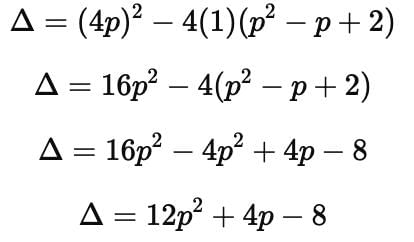
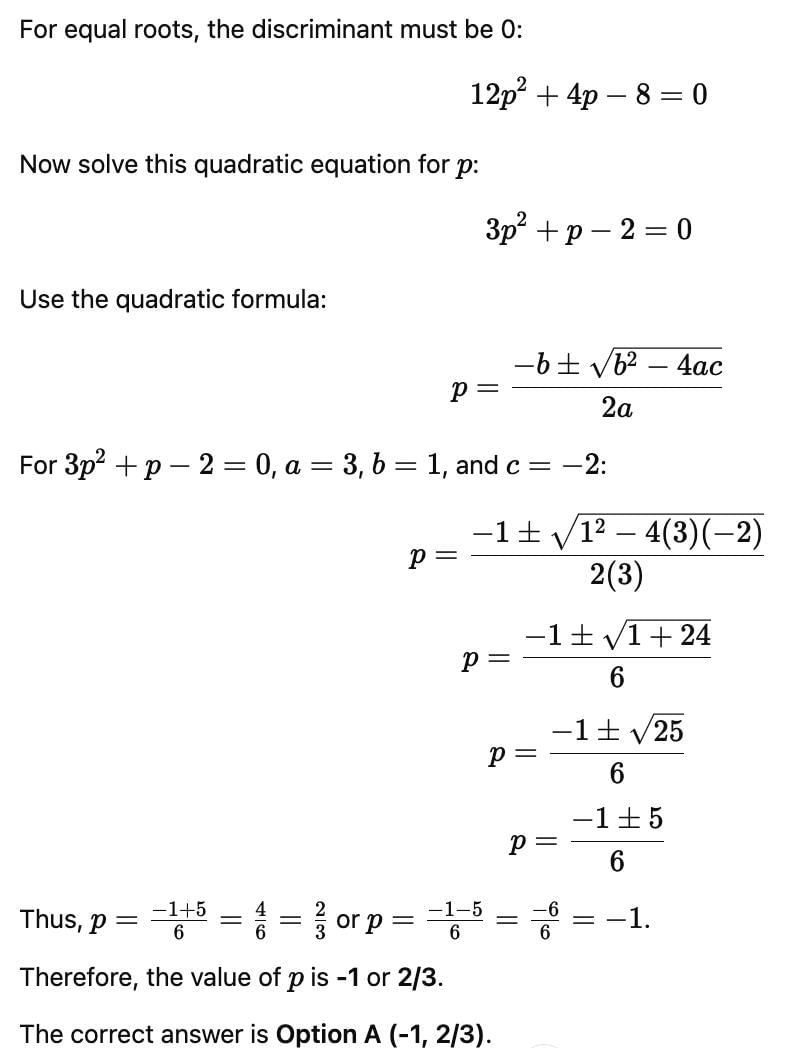
Which of the following statement is TRUE?
- a)A quadratic equation in variable x is of the form ax2 + bx + c = 0, where a, b, c are real numbers a ≠ o.
- b)If we can factorise ax2 + bx + c, a ≠ 0 into product of two linear factors then roots can be found by equating each factor to zero
- c)A real number R is said to be a root of the quadratic equation ax2 + bx + c = 0 if a(R)2 + bR + c = 0.
- d)All the above
Correct answer is option 'D'. Can you explain this answer?
Which of the following statement is TRUE?
a)
A quadratic equation in variable x is of the form ax2 + bx + c = 0, where a, b, c are real numbers a ≠ o.
b)
If we can factorise ax2 + bx + c, a ≠ 0 into product of two linear factors then roots can be found by equating each factor to zero
c)
A real number R is said to be a root of the quadratic equation ax2 + bx + c = 0 if a(R)2 + bR + c = 0.
d)
All the above
|
|
Anita Menon answered |
A quadratic equation in variable x is of the form ax2+ bx + c = 0, where a, b, c are real numbers a ≠ o, because if a=0 then the equation becomes a linear equation.
If we can factorise ax2 + bx + c, a ≠ 0 into product of two linear factors then roots can be found by equating each factor to zero because if two factors are in multiplication and equal to zero then either of the factor is zero.
A real number R is said to be a root of the quadratic equation ax2 + bx + c = 0 if a(R)2 + bR + c = 0. , root means that the value gives answer equal to zero.
So all are correct.
If we can factorise ax2 + bx + c, a ≠ 0 into product of two linear factors then roots can be found by equating each factor to zero because if two factors are in multiplication and equal to zero then either of the factor is zero.
A real number R is said to be a root of the quadratic equation ax2 + bx + c = 0 if a(R)2 + bR + c = 0. , root means that the value gives answer equal to zero.
So all are correct.
If -3 is a root of both the Quadratic equations 2x2 + px – 15 = 0, and p(x2 + x) + q = 0, then the value of q if the equation containing it has equal roots is- a)1/2
- b)1/4
- c)14
- d)2
Correct answer is option 'B'. Can you explain this answer?
If -3 is a root of both the Quadratic equations 2x2 + px – 15 = 0, and p(x2 + x) + q = 0, then the value of q if the equation containing it has equal roots is
a)
1/2
b)
1/4
c)
14
d)
2
|
|
Ananya Das answered |
-3 is root of both
2(9) -3p -15 = 0
p = 1
and
second equation has two equal roots so,
b2-4ac = 0
p2 = 4pq
p = 4q
q = 1/4
Which of the following equations has the sum of its roots as 3?
- a)3x2-3x+3 = 0
- b)2x2-3x+6 = 0
- c)-x2+3x-3 = 0
- d)x2+5x+6 = 0
Correct answer is option 'C'. Can you explain this answer?
Which of the following equations has the sum of its roots as 3?
a)
3x2-3x+3 = 0
b)
2x2-3x+6 = 0
c)
-x2+3x-3 = 0
d)
x2+5x+6 = 0
|
|
Anjana Khatri answered |
sum of root = -b/a
for (3) option sum of roots will be -(3)/(-1) = 3
for (3) option sum of roots will be -(3)/(-1) = 3
If x = -2 is a root of equation x2 – 4x + K = 0 then value of K is
- a)8
- b)-8
- c)-12
- d)12
Correct answer is option 'C'. Can you explain this answer?
If x = -2 is a root of equation x2 – 4x + K = 0 then value of K is
a)
8
b)
-8
c)
-12
d)
12
|
|
Mahi Rastogi answered |
(-2)²-4×-2+k=0
4+8+k=0
12+k=0
k=-12} ans
4+8+k=0
12+k=0
k=-12} ans
If x = 1 is a root of equation x2 – Kx + 5 = 0 then value of K is- a)4
- b)6
- c)-6
- d)5
Correct answer is option 'B'. Can you explain this answer?
If x = 1 is a root of equation x2 – Kx + 5 = 0 then value of K is
a)
4
b)
6
c)
-6
d)
5
|
|
Ananya Das answered |
Root of the equation means that the value when substituted in the equation gives zero as answer.
x2 - kx + 5 = 0
Putting x = 1
1*1 -k + 5 = 0
-k+6=0
k=6
x2 - kx + 5 = 0
Putting x = 1
1*1 -k + 5 = 0
-k+6=0
k=6
A real number is said to be a root of ax2+bx+c = 0- a)

- b)

- c)

- d)

Correct answer is option 'D'. Can you explain this answer?
A real number is said to be a root of ax2+bx+c = 0
a)
b)
c)
d)
|
|
Sameer Diwan answered |
Ni pta re bhai kya likha hai kuch samaj bhi ni aa ra
Zeroes of the quadratic polynomial ax2 + bx + c and roots of the quadratic equation ax2 + bx + c = 0 are ——–- a)Equal to zero
- b)Different
- c)Same
- d)Either same or different
Correct answer is option 'C'. Can you explain this answer?
Zeroes of the quadratic polynomial ax2 + bx + c and roots of the quadratic equation ax2 + bx + c = 0 are ——–
a)
Equal to zero
b)
Different
c)
Same
d)
Either same or different
|
|
Krishna Iyer answered |
Zeros of the polynomial means the value of variable such that the equation is equal to zero.Roots of the equation means the value of the variable for which LHS=RHS which basically means that the equation is equal to zero. Hence Zeros and roots are one and the same thing.
Equation ax2 + 2x + 1 has one double root if :- a)a = 0
- b)a = – 1
- c)a = 1
- d)a = 2
Correct answer is option 'C'. Can you explain this answer?
Equation ax2 + 2x + 1 has one double root if :
a)
a = 0
b)
a = – 1
c)
a = 1
d)
a = 2
|
|
Sagar rana answered |
The equation ax^2 + 2x + 1 has one double root if a = 0.
A shopkeeper buys a number of books for Rs. 80. If he had bought 4 more for the same amount, each book would have cost Re. 1 less. How many books did he buy?- a)8
- b)16
- c)24
- d)28
Correct answer is option 'B'. Can you explain this answer?
A shopkeeper buys a number of books for Rs. 80. If he had bought 4 more for the same amount, each book would have cost Re. 1 less. How many books did he buy?
a)
8
b)
16
c)
24
d)
28
|
|
Sonia malhotra answered |
Given, a shopkeeper buys a number of books for Rs. 80.
Let the number of books he bought be x.
Then, the cost of each book = 80/x
According to the question, if he had bought 4 more books for the same amount, each book would have cost Re. 1 less.
So, the new number of books he would have bought = x + 4
And, the cost of each book would be = 80/(x+4)
Also, it is given that each book would have cost Re. 1 less, so we can write:
80/x - 1 = 80/(x+4)
Simplifying this equation, we get:
80x + 320 = 80x - x^2 + 4x
Rearranging and simplifying further, we get:
x^2 - 4x - 320 = 0
Factorizing this quadratic equation, we get:
(x - 20)(x + 16) = 0
So, the possible values of x are 20 and -16. But since x represents the number of books he bought, it cannot be negative. Therefore, x = 20.
Hence, the shopkeeper bought 20 books.
Let the number of books he bought be x.
Then, the cost of each book = 80/x
According to the question, if he had bought 4 more books for the same amount, each book would have cost Re. 1 less.
So, the new number of books he would have bought = x + 4
And, the cost of each book would be = 80/(x+4)
Also, it is given that each book would have cost Re. 1 less, so we can write:
80/x - 1 = 80/(x+4)
Simplifying this equation, we get:
80x + 320 = 80x - x^2 + 4x
Rearranging and simplifying further, we get:
x^2 - 4x - 320 = 0
Factorizing this quadratic equation, we get:
(x - 20)(x + 16) = 0
So, the possible values of x are 20 and -16. But since x represents the number of books he bought, it cannot be negative. Therefore, x = 20.
Hence, the shopkeeper bought 20 books.
Directions: In the following questions, A statement of Assertion (A) is followed by a statement of Reason (R). Mark the correct choice as.Assertion (A): The equation 8x2 + 3kx + 2 = 0 has equal roots than the value of k is ±  Reason (R): The equation ax2 + bx + c = 0 has equal roots if D = b2 – 4ac = 0.
Reason (R): The equation ax2 + bx + c = 0 has equal roots if D = b2 – 4ac = 0.- a)Both A and R are true and R is the correct explanation for A.
- b)Both A and R are true and R is not correct explanation for A.
- c)A is true but R is false.
- d)A is false but R is true.
Correct answer is option 'A'. Can you explain this answer?
Directions: In the following questions, A statement of Assertion (A) is followed by a statement of Reason (R). Mark the correct choice as.
Assertion (A): The equation 8x2 + 3kx + 2 = 0 has equal roots than the value of k is ± 

Reason (R): The equation ax2 + bx + c = 0 has equal roots if D = b2 – 4ac = 0.
a)
Both A and R are true and R is the correct explanation for A.
b)
Both A and R are true and R is not correct explanation for A.
c)
A is true but R is false.
d)
A is false but R is true.

|
Flembe Academy answered |
Reason perfectly explains the nature of roots when D = 0 for any quadratic equation.
Let us apply the reason on the equation,
8x2 + 3kx + 2 = 0
D = b2 – 4ac = 0
⇒ (3k)2 – 4(8) (2) = 0
⇒ 9k2 – 64 = 0
⇒ 

The roots of the equation x2 – 3x – m (m + 3) = 0, where m is a constant, are- a)–m, m + 3
- b)m, m + 3
- c)–m, – (m + 3)
- d)m, – (m+3)
Correct answer is option 'A'. Can you explain this answer?
The roots of the equation x2 – 3x – m (m + 3) = 0, where m is a constant, are
a)
–m, m + 3
b)
m, m + 3
c)
–m, – (m + 3)
d)
m, – (m+3)
|
|
Aditya Shah answered |
X^2 - 3x - m(m+3) = 0
=> x^2 + mx - (m+3)x- m(m+3) = 0
=> x(x+m) - (m+3)(x+m) = 0
=> (x+m) (x-m-3) = 0
x = - m and m+3
Roots are - m and m+3
The real roots of a quadratic equation  are given by
are given by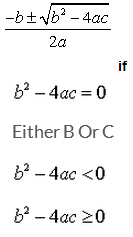
- a)A
- b)B
- c)C
- d)D
Correct answer is 'D'. Can you explain this answer?
The real roots of a quadratic equation  are given by
are given by
a)
A
b)
B
c)
C
d)
D
|
|
Ishan Choudhury answered |
When b2 - 4ac=0 then we have the root as -b/2a.
When b2-4ac < 0,then the root is a complex root ,since we have a negative number ,for which real square root is not possible.
When b2 - 4ac > 0 then we have a square root of it and hence we have real roots. So the correct answer is b2 - 4ac > 0
When b2-4ac < 0,then the root is a complex root ,since we have a negative number ,for which real square root is not possible.
When b2 - 4ac > 0 then we have a square root of it and hence we have real roots. So the correct answer is b2 - 4ac > 0
The sum of the ages of two friends is 20 years. Four years ago, the product of their ages in years was 48. Find their present ages- a)2 and 18
- b)The situation is not possible
- c)6 and 14
- d)10 and 10
Correct answer is option 'B'. Can you explain this answer?
The sum of the ages of two friends is 20 years. Four years ago, the product of their ages in years was 48. Find their present ages
a)
2 and 18
b)
The situation is not possible
c)
6 and 14
d)
10 and 10
|
|
Ayush Iyer answered |
Let's assume the present ages of the two friends are x and y.
According to the given information, the sum of their ages is 20 years.
So, we can write the equation: x + y = 20.
Four years ago, the product of their ages was 48.
So, four years ago, their ages would have been x - 4 and y - 4.
The product of their ages four years ago is: (x - 4)(y - 4) = 48.
Now, let's solve these two equations to find the values of x and y.
Solving the first equation, x + y = 20, we can express x in terms of y:
x = 20 - y.
Substituting the value of x in the second equation, we have:
(20 - y - 4)(y - 4) = 48.
Simplifying this equation, we get:
(16 - y)(y - 4) = 48
16y - 4y - 64 = 48
12y = 112
y = 9.33.
Since y is not a whole number, it means there are no two whole numbers that satisfy the given conditions. Therefore, the situation is not possible.
Hence, the correct answer is option B - The situation is not possible.
According to the given information, the sum of their ages is 20 years.
So, we can write the equation: x + y = 20.
Four years ago, the product of their ages was 48.
So, four years ago, their ages would have been x - 4 and y - 4.
The product of their ages four years ago is: (x - 4)(y - 4) = 48.
Now, let's solve these two equations to find the values of x and y.
Solving the first equation, x + y = 20, we can express x in terms of y:
x = 20 - y.
Substituting the value of x in the second equation, we have:
(20 - y - 4)(y - 4) = 48.
Simplifying this equation, we get:
(16 - y)(y - 4) = 48
16y - 4y - 64 = 48
12y = 112
y = 9.33.
Since y is not a whole number, it means there are no two whole numbers that satisfy the given conditions. Therefore, the situation is not possible.
Hence, the correct answer is option B - The situation is not possible.
If the value of the Discriminant function of a quadratic equation is D = 27, then its roots are- a)Distinct, Rational
- b)Same Irrational
- c)Distinct, Irrational
- d) Same, Rational
Correct answer is option 'C'. Can you explain this answer?
If the value of the Discriminant function of a quadratic equation is D = 27, then its roots are
a)
Distinct, Rational
b)
Same Irrational
c)
Distinct, Irrational
d)
Same, Rational
|
|
Roshni chauhan answered |
Quadratic equation is a polynomial equation of degree two, which can be written in the form of ax² + bx + c = 0. The discriminant of a quadratic equation is given by D = b² - 4ac. It is a function of the coefficients of the quadratic equation and is used to determine the nature of the roots of the equation.
Distinct and Irrational Roots
If the value of the discriminant is positive and a perfect square, then the roots of the quadratic equation are distinct and rational. If the value of the discriminant is positive but not a perfect square, then the roots of the quadratic equation are distinct and irrational.
Same and Rational Roots
If the value of the discriminant is zero, then the roots of the quadratic equation are same and rational. If the value of the discriminant is negative, then the roots of the quadratic equation are complex conjugates.
Given, D = 27
From the above discussion, we know that if the value of the discriminant is positive and not a perfect square, then the roots of the quadratic equation are distinct and irrational.
Therefore, the correct answer is option C, which states that the roots of the quadratic equation are distinct and irrational.
Distinct and Irrational Roots
If the value of the discriminant is positive and a perfect square, then the roots of the quadratic equation are distinct and rational. If the value of the discriminant is positive but not a perfect square, then the roots of the quadratic equation are distinct and irrational.
Same and Rational Roots
If the value of the discriminant is zero, then the roots of the quadratic equation are same and rational. If the value of the discriminant is negative, then the roots of the quadratic equation are complex conjugates.
Given, D = 27
From the above discussion, we know that if the value of the discriminant is positive and not a perfect square, then the roots of the quadratic equation are distinct and irrational.
Therefore, the correct answer is option C, which states that the roots of the quadratic equation are distinct and irrational.
Read the following text and answer the following questions on the basis of the same:A small scale industry produces a certain boxes of candles in a day. Number of boxes prepared by each worked on a particular day was 2 more than thrice the number of workers working in the industry. The number of boxes produced in a particular day was 85.Q. Number of workers working in the industry:- a)5
- b)6
- c)17
- d)8
Correct answer is option 'A'. Can you explain this answer?
Read the following text and answer the following questions on the basis of the same:
A small scale industry produces a certain boxes of candles in a day. Number of boxes prepared by each worked on a particular day was 2 more than thrice the number of workers working in the industry. The number of boxes produced in a particular day was 85.
Q. Number of workers working in the industry:
a)
5
b)
6
c)
17
d)
8
|
|
Avinash Patel answered |
Let the workers are x, Number of boxes prepared by the workers
= 2 + 3x
According to the question,
x(2 + 3x) = 85
⇒ 3x2 + 2x – 85 = 0
⇒ 3x2 + 17x – 15x – 85 = 0
⇒ x(3x + 17) – 5(3x + 17) = 0 ⇒
⇒ (3x + 17)(x – 5) = 0
⇒ x = 5
Chapter doubts & questions for Quadratic Equations - Mathematics Class 10 (Maharashtra SSC Board) 2025 is part of Class 10 exam preparation. The chapters have been prepared according to the Class 10 exam syllabus. The Chapter doubts & questions, notes, tests & MCQs are made for Class 10 2025 Exam. Find important definitions, questions, notes, meanings, examples, exercises, MCQs and online tests here.
Chapter doubts & questions of Quadratic Equations - Mathematics Class 10 (Maharashtra SSC Board) in English & Hindi are available as part of Class 10 exam.
Download more important topics, notes, lectures and mock test series for Class 10 Exam by signing up for free.

Contact Support
Our team is online on weekdays between 10 AM - 7 PM
Typical reply within 3 hours
|
Free Exam Preparation
at your Fingertips!
Access Free Study Material - Test Series, Structured Courses, Free Videos & Study Notes and Prepare for Your Exam With Ease

 Join the 10M+ students on EduRev
Join the 10M+ students on EduRev
|

|
Create your account for free
OR
Forgot Password
OR
Signup on EduRev and stay on top of your study goals
10M+ students crushing their study goals daily


